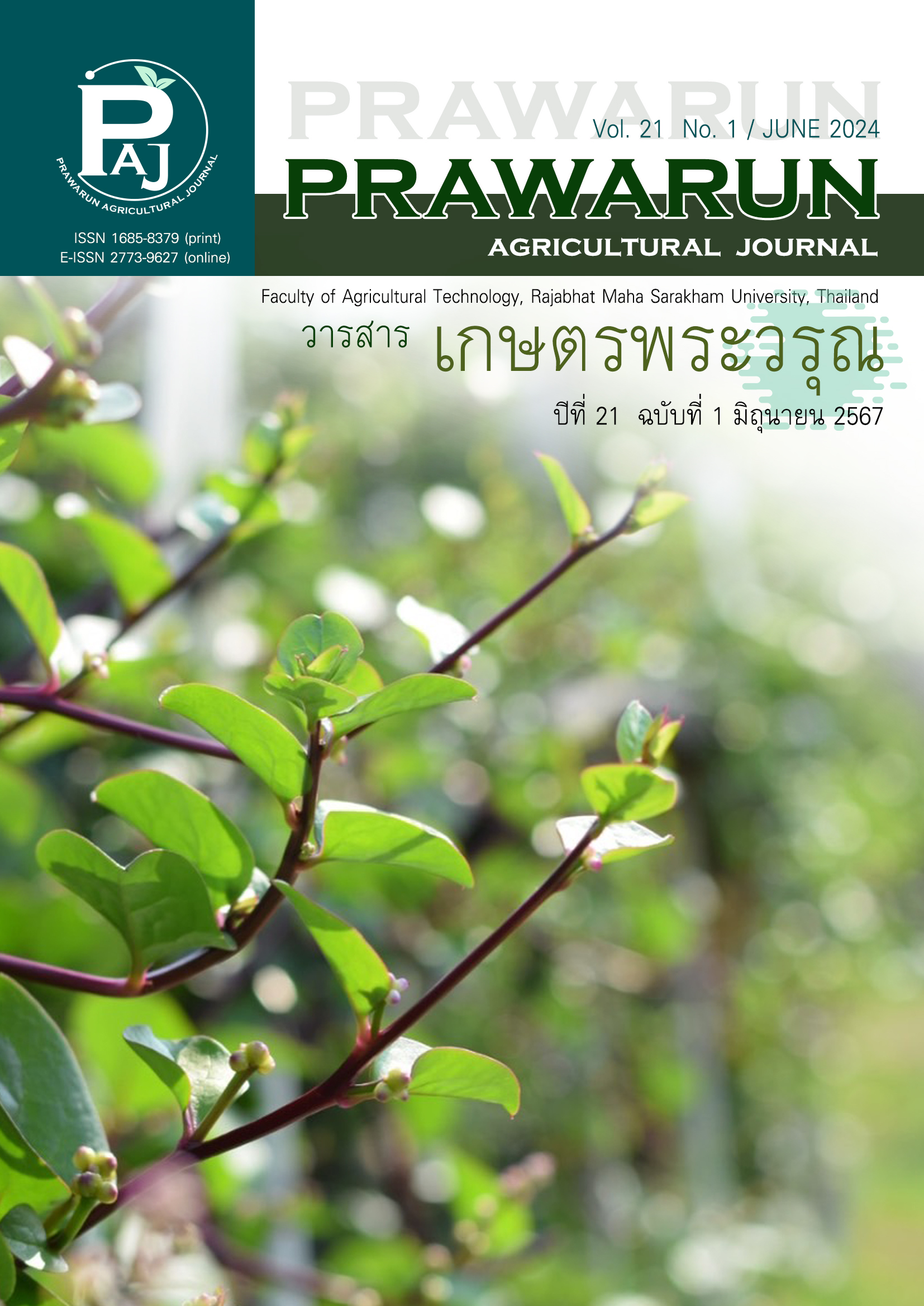การพัฒนาผลิตภัณฑ์แยมกล้วยหอมทองเสริมสับปะรดศรีราชา
Main Article Content
บทคัดย่อ
งานวิจัยนี้มีวัตถุประสงค์เพื่อพัฒนาผลิตภัณฑ์แยมกล้วยหอมทองเสริมสับปะรดศรีราชา โดยศึกษาปริมาณการเสริมสับปะรดที่เหมาะสมในการผลิตผลิตภัณฑ์แยมกล้วยหอมทอง ร้อยละ 0 26.50 42 และ 59.25 โดยน้ำหนักของกล้วยหอมทอง ผลการวิเคราะห์การยอมรับของผู้บริโภคทางด้านประสาทสัมผัส คุณภาพทางกายภาพ ทางเคมี และอายุการเก็บรักษา พบว่า การเสริมสับปะรดที่เหมาะสมในการผลิตแยมกล้วยหอมทอง คือ การเสริมสับปะรดร้อยละ 26.50 ผู้บริโภคให้การยอมรับมากที่สุด มีคะแนนความชอบโดยรวมเท่ากับ 7.97 หรือระดับความชอบปานกลาง (9-point hedonic scale โดย 9 = ชอบมากที่สุด 1 = ไม่ชอบมากที่สุด) มีค่าความสว่าง (L*) และค่าความเป็นสีเหลือง (b*) ที่มีค่าใกล้เคียงกับสูตรควบคุม การเสริมสับปะรดร้อยละ 26.50 ทำให้ค่าความแข็งของเจล (Hardness) มีค่าต่ำกว่าสูตรควบคุม ขณะที่ค่าการเกาะกันของเจล (Adhesiveness) สูงกว่า และเมื่อนำมาวิเคราะห์ปริมาณกรดในรูปกรดซิตริก มีค่าร้อยละ 1.13 และการเสริมสับปะรดร้อยละ 26.50 ส่งผลให้มีปริมาณความชื้นเพิ่มสูงขึ้น เท่ากับร้อยละ 37.31 โดยมีปริมาณเส้นใยและปริมาณเถ้าไม่แตกต่างกันกับสูตรควบคุม แยมกล้วยหอมทองเสริมสับปะรดร้อยละ 26.50 มีอายุการเก็บรักษาที่อุณหภูมิ 28-30 องศาเซลเซียส ได้มากกว่า 28 วัน จากผลการศึกษานำไปสู่การถ่ายทอดเทคโนโลยีกระบวนการผลิตและแปรรูปให้แก่กลุ่มวิสาหกิจชุมชนผักปลอดภัยไทดอนบาก ตำบลบ้านโคก อำเภอสร้างคอม จังหวัดอุดรธานี สามารถผลิตแยมจากกล้วยหอมทองเสริมสับปะรด ซึ่งสามารถจำหน่ายเป็นผลิตภัณฑ์ใหม่ของวิสาหกิจชุมชนได้
Article Details
เอกสารอ้างอิง
Aimi Azira, S., Wan Zunairah, W. I., Nor Afizah, M., Nor-Khaizura, M. A. R., Radhiah, S., Ismail Fitry, M. R., & Nur Hanani, Z. A. (2021). Prevention of browning reaction in banana jam during storage by physical and chemical treatments. Food Research, 5(5), 55-62.
Apiratananusorn, S. (2011). Development of low calorie mangosteen jam supplemented with rind of mangosteen. KKU Research Journal, 16(7), 825-834. (in Thai)
Association of Official Analytical Chemists (AOAC). (2004). Official methods of analysis of AOAC international (17th ed.). Gaithersburg, Maryland: The Association of Official Analytical Chemists.
Association of Official Analytical Chemists (AOAC). (2000). Official methods of analysis of AOAC international (17th ed.). Gaithersburg, Maryland: The Association of Official Analytical Chemists.
Awolu, O. O., Okedele, G. O., Elizabeth, O. M., & Oseyemi, G. F. (2018). Functional jam production from blends of banana, pineapple, and watermelon pulp. International Journal of Food Science and Biotechnology, 3(1), 7-14. DOI:10.11648/j.ijfsb.20180301.12
Awulachew, M. T. (2021). Fruit jam production. International Journal of Food Science, Nutrition and Dietetics. 10(4), 532-537. doi:10.19070/2326-3350-2100092
Bureau of Nutrition, Department of Health. (2010). Nutritional value in fruits. Bangkok: Agricultural Cooperative Assembly Press, Ministry of Public Health. (in Thai)
Cantwell, M. (2022). Banana ripeness chart. Accessed February 5, 2023. Retrieved from http://ucanr.edu/sites/Postharvest_Technology_Center_/files/222603
Chuenban, K., Jangchud, A., & Jangchud, K. (2012). Optimization of formulation for mixed tropical fruits jam sheet. Proceedings of 50th Kasetsart university annual conference: Agro-Industry. (pp. 284-292). Bangkok: Kasetsart University. (in Thai)
Deepu, S. (2007). Study of fruit jam production (Report research). Phetchabun: Faculty of Science and Technology, Phetchabun Rajabhat University. (in Thai)
Huangrak, K. (1993). Vegetables and fruits (Teaching publications). Bangkok: Faculty of Agroindustry King Mongkut's Institute of Technology Ladkrabang. (in Thai)
Igual, M., Contreras, C., & Martinez-Navarrete, N. (2014). Color and rheological properties of non-conventional grapefruit jam: instrumental and sensory measurement. LWT-Food Science and Technology, 56(1), 200-206. doi: 10.1016/j.lwt.2013.10.038
Leenanurak, S. (1999). Fruit and vegetable processing. Chiang Mai: Food Science and Technology major, Faculty of Engineering and Agricultural Industry, Maejo University. (in Thai)
Muresan, C., Pop, A., Muste, S., Scrob, S., & Rat, A. (2014). Study concerning the quality of jam products based on banana and ginger. Journal of Agroalimentary Processes and Technologies, 20(4), 408-411.
Murray, M. T. (1996). The Encyclopedia of nutritional supplements. New York, United State: Prima Publishing.
Nukulthornprakit, O. (2004). Free radicals and antioxidants and brown gut symptoms in pineapples (Master’s thesis). Bangkok: Kasetsart University. (in Thai)
Patel, N. V., Naik, A. G., & Senapati, A. (2015). Quality evaluation and storage study of banana-pineapple blended jam. International Journal of Food Quality and Safety, 1, 45-51.
Phunpaisan, U., & Chomkitichai, W. (2021). Logo and packaging design for enhancement of Huai Mun pineapple fruits by using the data of correlation between peel color and taste. Academic Journal Uttaradit Rajabhat University Science and Technology (for Local Development), 16(2), 57-76. (in Thai)
Pongjanta, J., Nualbunruang A., Panchai, L., & Buaphan, T. (2011). Organic acids and sugar changes in pineapple juice (Ananas comosus cv. Smooth Cayenne) from different location planted and ripen degree. Proceedings of the 49th Kasetsart university annual conference: agro-industry (pp. 267-274). Bangkok: Kasetsart University. (in Thai)
Raikos, V., Campbell, L., & Euston, S. R. (2007). Rheology and texture of hen’s egg protein heat-set gels as affected by pH and the addition of sugar and/or salt. Food Hydrocolloids, 21(2), 237-244. doi: 10.1016/j.foodhyd.2006.03.015
Rattanapanon, N. (2002). Food Chemistry. Bangkok: Odean Store Publishing. (in Thai)Thai Industrial Standards Institute. (2018). Community product standards, Jam, TCPs, 342/2018. Accessed April 15, 2023. Retrieved from https://tcps.tisi.go.th/pub/tcps0342_61(jam).pdf.(in Thai)
Thaiphanit, S., & Anprung, P. (2014). Inhibition of browning reaction in pasteurized fragrant banana purée. Journal of Food Technology, Siam University, 9(1), 39-51. (in Thai)
Thongtham, J. (1983). Pineapple and the pineapple industry in Thailand. N.P. (in Thai)
Tiyapreechaya, P. (2010). Development of banana and papaya jam products by reducing sugar. (Research report). Chiang Mai: Faculty of Science Payap University. (in Thai)
Wan-Mohtar W. A. A. Q. I., Lim, S., Balamurugan, J. P., Saad, M. Z. M., Azizan, N. A. Z., Jamaludin, A. A., & Ilham, Z. (2021). Effect of sugar-pectin-citric acid pre-commercialization formulation on the physicochemical, sensory, and shelf-life properties of Musa cavendish banana jam. Sains Malaysiana, 50(5), 1329-1342. doi:10.17576/jsm-2021-5005-13
Weerawut, J. (1998). Pineapple and its growth physiology. Bangkok: Kasetsart University Press. (in Thai)


